An oscilloscope is a device that we use to measure or analyze changes in any electrical signal, and to study the behavior of a system, within its bandwidth limits. It displays an electrical signal with respect to time, so you can see every detail of the signal i.e., its shape, frequency, amplitude, and distortion.
Because the best reliable oscilloscope is so important that from day one there are a lot of industry-leading oscilloscope manufacturers out there on the market i.e Tekpower, Keithley, Keysight, Aim-TTI, Rohde and Schwarz, and some new guys like Rigol, Hantek, Siglent Technologies, and GW Instek
Now, choosing the best beginner oscilloscopes or any level scope might be a little confusing for some guys, as there are many manufacturers, technical parameters to look for, and of course what should you pay for which feature.
And perhaps a lot of many more questions.
Here in this post, I try my best to help you find the best oscilloscope no matter if you are a beginner, hobbyist, student, or professional.
Let’s get started.
Best oscilloscopes
Well, I just cannot emphasize how much a quality oscilloscope is the basic need of every electronics hobbyist or beginner, or any person involved in electronics.
The best oscilloscope that I (electronics engineer) and professionals recommend especially for beginner level electronics is either the Rigol DS1052E or Siglent SDS1104X-E. They are best for value and price. Thousands of beginners have used them and are quite satisfied with their quality and performance.
Following are some oscilloscope models that you should consider. At the end of this list, I also have included a buying guide to help you select the best oscilloscope according to your needs and projects.
1. Rigol DS1052E
Let’s start talking about our first oscilloscope from the Rigol brand. I am sure, you may have heard of this brand in your own research on the best beginner oscilloscopes if this post is not your very first.
Talking about the Rigol. It is a well-known company, making digital oscilloscopes since 1999. Its products have been used worldwide and people are very much satisfied with its products.
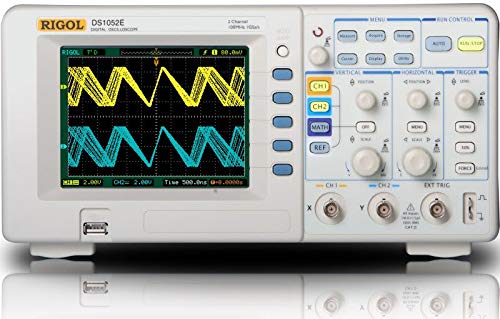
Important Features:
- The model has 2 channels, best for beginners and car diagnosis. And if you are dealing with a lot of signals at once, this model is for you.
- 50MHz bandwidth, which is half the above Siglent model
- 1 GSa/s real-time sample rate
- External triggering
- Math functions including FFT
- 1 Mpts memory depth, same as the above model
- It comes in nice packing and has a beautiful bright screen.
- It feels so great, one enjoys working with it
In summary, the Rigol DS1052E (Amazon Link) is the best oscilloscope for beginners out there. It has a decent price tag and has all the functionality you will need for your electronics projects.
2. FNIRSI 1014D Digital Oscilloscope
The second digital oscilloscope is from the Fnirsi brand. The oscilloscope is called the 1014D. The best thing about this oscilloscope is that it has built in function generator as well.
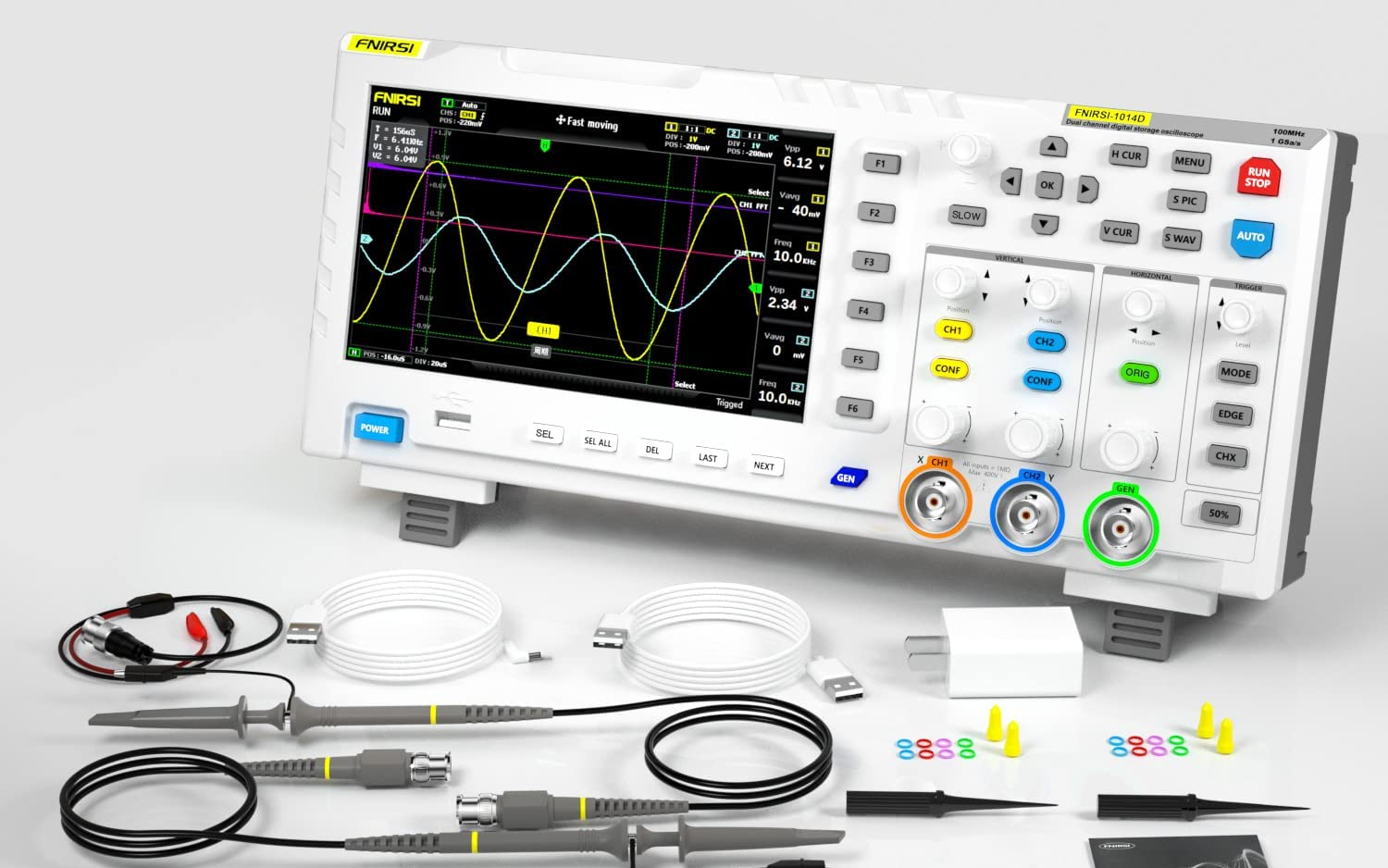
Important features:
- It has an analog bandwidth of 100MHz
- It has 2 channels and the bandwidth doesn’t split among them.
- It has a 1GSa/s sample rate which is amazing.
- It has built in signal generator
In a short summary, the FNIRSI 1014D Digital Oscilloscope (Amazon link) is a high quality oscilloscope for such a low price tag. It can be used for a wide range of applications. Its advanced features and high-quality performance make it an excellent choice for professionals and enthusiasts alike.
3. Rigol DS1054Z Digital Oscilloscope
The above one from the Rigol brand is a very beginner oscilloscope with 50MHz bandwidth and 2 channels. Now if you want to go for a little advanced oscilloscope from this same brand. Then you can have DS1054Z.
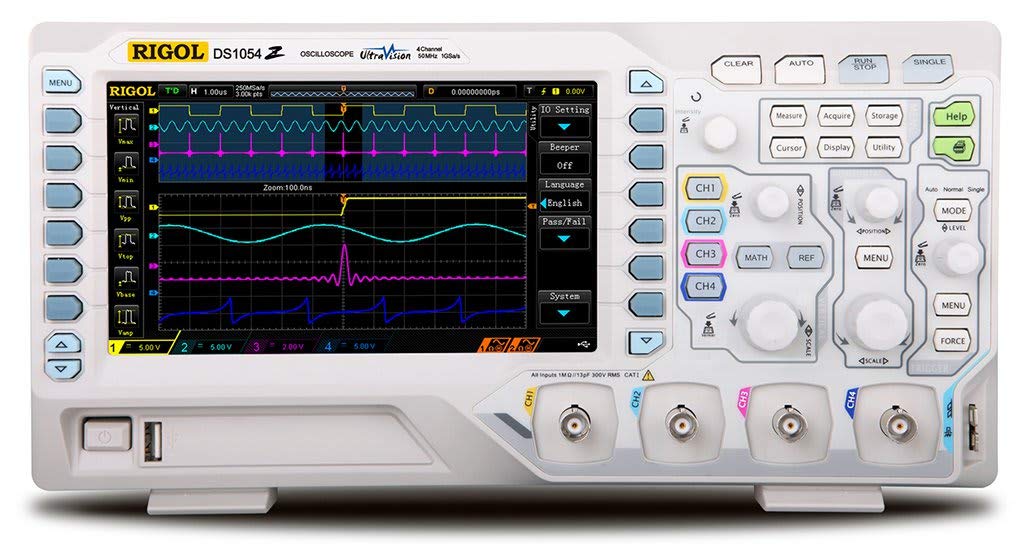
Important features:
- Analog channel bandwidth: 100 MHz, 70 MHz, 50 MHz
- The number of channels is 4 which is amazing if you want to compare various signals at the same time.
- Deep Memory Depth (up to 24 Mpts)
- 7 inch WVGA (800×480) TFT LCD, intensity graded color display
- Record up to 60,000 frames of a dynamic signal and play them back like a movie for analysis and training.
In a summary, If you are looking for 4 channels, then Rigol DS1054Z (Amazon link) is a good option to consider.
This guy has upgradable bandwidth which is a very cool feature. Later you decide to go for higher bandwidth, then you would not need to buy other scopes just upgrade the bandwidth of your exciting scope.
4. The best beginner oscilloscope from Siglent (SDS1104X-E)
Siglent Technology is new to the oscilloscope industry but its models are too reliable and affordable. I did research on every model, read people’s reviews, saw videos, and used my own engineering knowledge to compare it with other brands.
In the end, I am very happy and positive about this brand. As I said, there are a lot of models from this brand. I personally like the mentioned model too much.
Important Features:
- It has got 100MHz bandwidth, a kind of ideal for a beginner person
- The sample rate of 1Gs/s is real-time making the scope so powerful.
- A lot of math functions including the FFT function. This feature is important if you want to analyze the signal in the frequency domain.
- Four channels and with external triggering option
- Memory depth of IMpts
- Large 7-inch TFT-LCD display with 800 * 480 resolution
- Quick boot time, small size, and feels very solid
- Computer connectivity includes old RS-232 and new USB connection
- USB storage for saving purposes
- Pass/Fail out the connection
In summary, the Siglent SDS1104X-E (Amazon Link), the best oscilloscope for beginners, is the tool to measure all your signals, sum them, subtract them, and give you the power of each signal, and give you the frequency content of it.
5. Siglent SDS1202X-E
If you want to look at another model from the same brand i.e. Siglent. Then you can look for SDS1202X-E. It has almost identical specs as that of the above one.
It has 200MHz bandwidth twice the above one. The number of channels is two which can do all your measurements. To know more about this guy. Here is the link, Siglent SDS1202X-E (Amazon link), for your own investigation.
6. The best beginner oscilloscope from Hantek (DSO5102P)
I do not think Hantek needs any introduction for the majority of your people. It is well known for providing quality oscilloscopes. It has almost all the features as in the above oscilloscope.
I love the model DSO5102P from Hantek for the beginners out there. It is simply amazing.
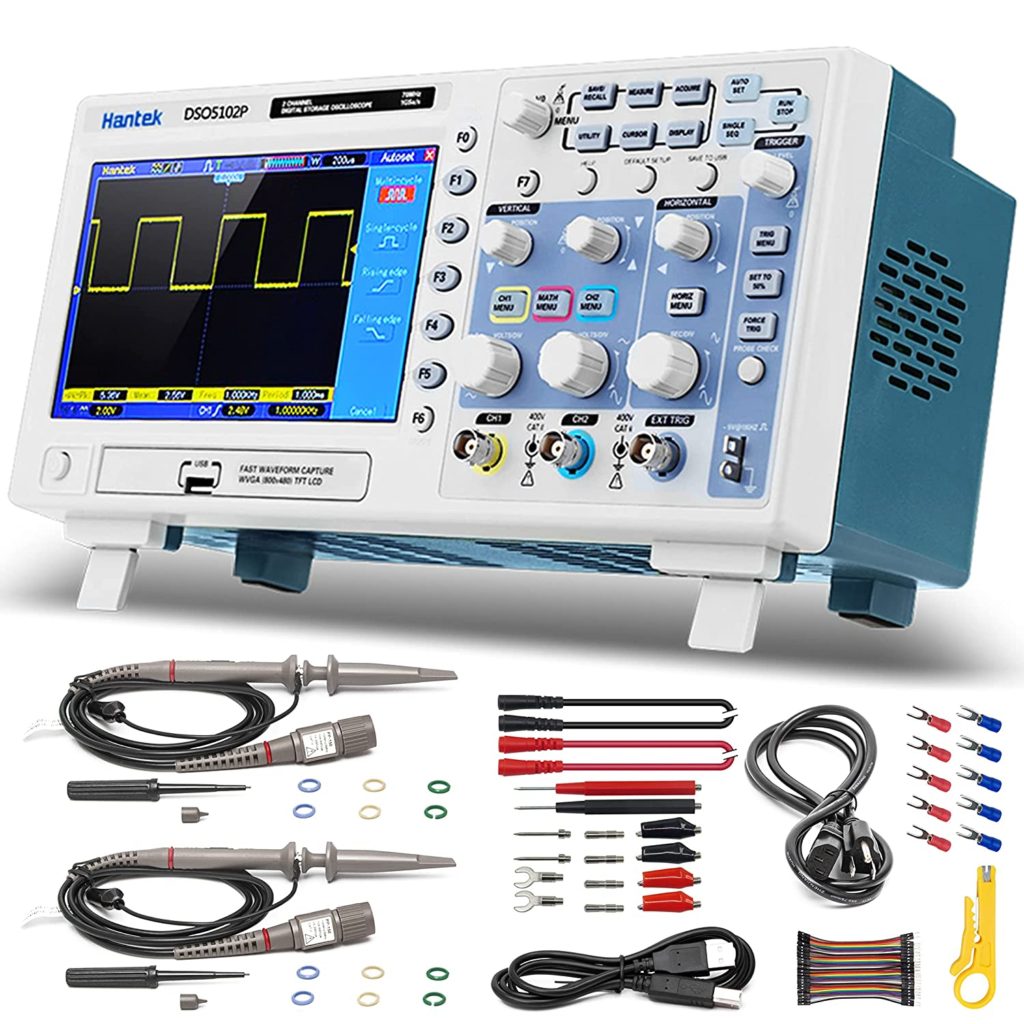
Important features:
- It has got a bandwidth of 100MHz which is comparable with the above-mentioned models
- No of the measuring channels are 2, pretty standard
- The sample rate of 1GS/s, same as the above Siglent model
- Got memory depth of 40K, not impressive but decent
- 8bit of ADC resolution
In summary, the Hantek DSO5102P (Amazon Link) can be the best alternative to the above ones if someone is low on budget. It is the most inexpensive scope in comparison with the above list because you are directly buying from the manufacturer.
7. HANMATEK DOS1102 Digital Oscilloscope
The next best oscilloscope is from the Hanmatek brand. This brand is also a proven brand when it comes to producing high quality electronics testing instruments.
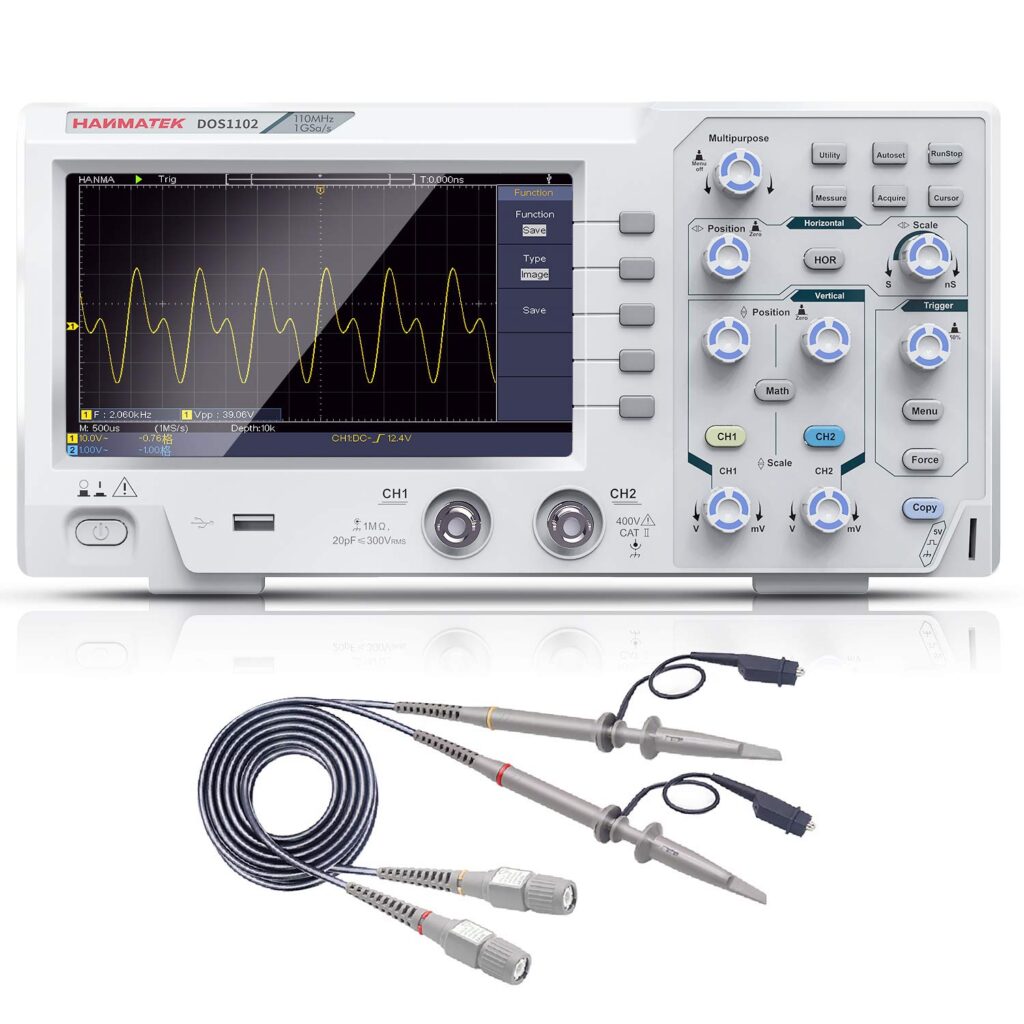
Important features:
- It has a bandwidth of 100MHz
- 2 channels with wide digital screen
- 1 GS/s sampling rate
- It has 30 kinds of automatic measurement functions and can customize the measurement menu
- It has the waveform interception function and can be seamlessly connected with the same brand signal generators.
- Support LABVIEW communication, and support secondary development.
In a short summary, the HANMATEK DOS1102 Digital Oscilloscope (Amazon link) is one of the unique high quality oscilloscopes you can have in your lab.
8. YEAPOOK ADS1014D
The last best oscilloscope I have for you is the ADS1014D from the Yeapook brand. This oscilloscope is of low price and has really amazing features.
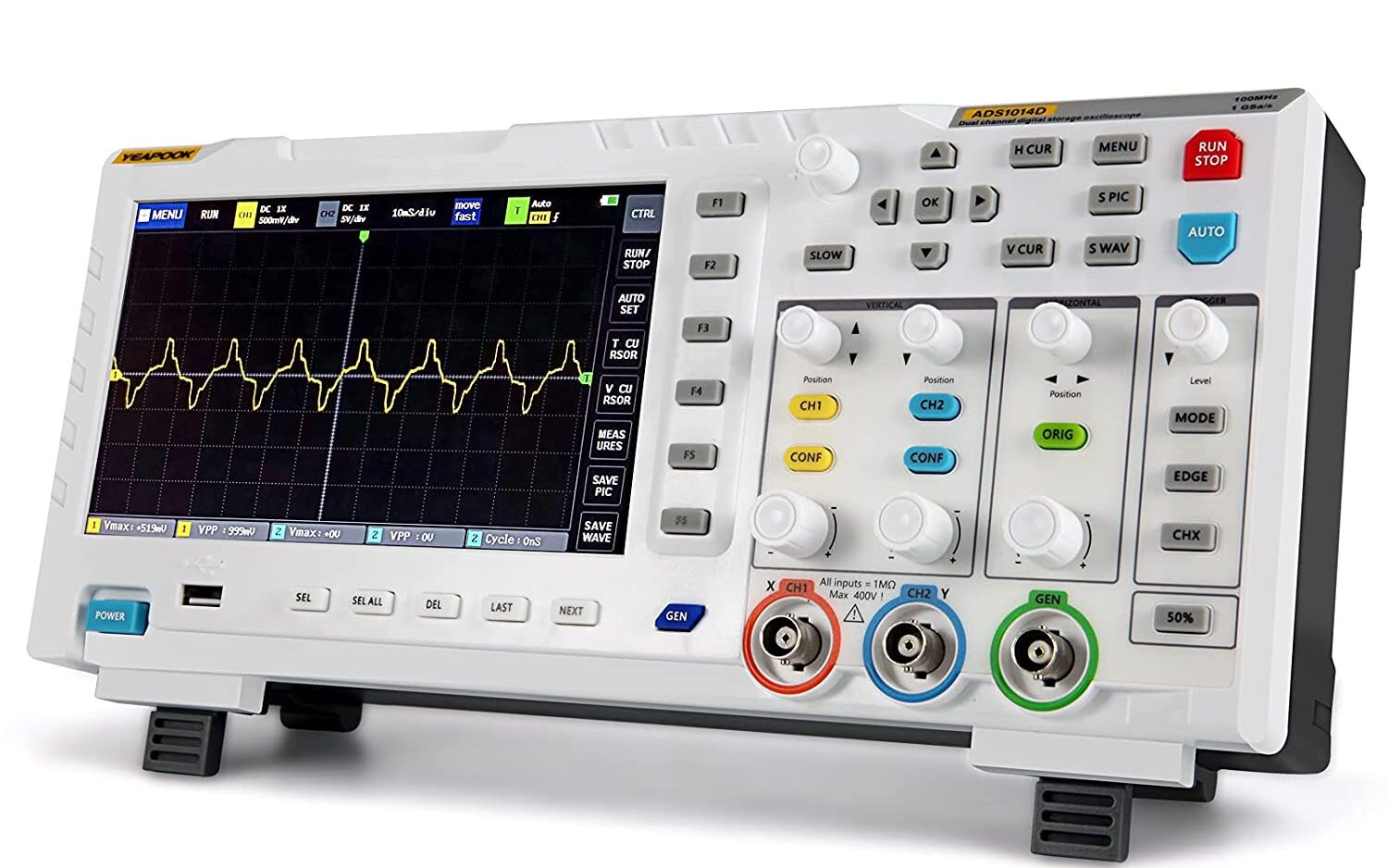
Important features:
- It has a bandwidth of 100MHz with real time 1 GSa/s sample rate.
- 240 kbit Sample memory depth
- 2 channels
- Built in DDS Function Signal Generator
- It can store up to 1000 customized signals
In a short summary, the YEAPOOK ADS1014D (Amazon link) can be used to compare and judge the amplitude, frequency, and phase of two groups of signals. The FFT function can estimate the harmonic component of signals.
Oscilloscope selection
The selection of the best beginner oscilloscope depends on a few things and parameters.
It also depends on who you are, i.e., a design engineer to diagnose operational and design problems, an automotive engineer measuring the vibrations, a repair technician, or you’re simply trying to maintain your electronic pieces of equipment.
Answering the following questions first will be very helpful.
- For what situation do you need a scope i.e., where are you going to use it? For example on the bench, at a customer’s site, or under the hood of your car.
- How many signals do you want to measure at once? For example, how many measuring channels you will require in your scope?
- A guess of the highest frequencies you will measure with the scope. According to my opinion, you should be very sure of your frequency range to be measured by the scope. This question is very important, please pay very close attention to it. As it is directly in relation to the oscilloscope price tag.
- What are the amplitudes of your signals? In case you don’t know, leave it. It is fine.
- Are the signals you are going to measure periodic or non-periodic?
A bench scope is a little heavy and specific for more professional work at the lab. The bench scope is relatively more expensive than the rest. If you are going to use your scope in the field, or for car diagnosis, you need a portable one.
Questions to answer first
We talked about the technical stuff to get ourselves comfortable to answer the following questions. I recommend, answering them very carefully.
a. How much bandwidth you will require?
Multiply your highest frequency by 5. For example, if your highest measuring frequency is 10MHz, then the ideal beginner oscilloscope for you would be one with a bandwidth of 50MHz.
For the said highest frequency you can also use a scope with 100MHz bandwidth, but it is not a good idea. Because it will cost you more money and most importantly you may end up getting a high noise floor as well. If you are thinking you are not sure about the future, you can upgrade the bandwidth if needed.
b. How much sample rate you will need?
Follow the Nyquist criterion which states that the sampling rate must be at least twice the maximum frequency that you want to measure. For example, if your maximum frequency is 10MHz then the ideal scope for you must have a sample rate of 20MS/s. Again higher sample rate will end in costing more money.
c. Analysis & capture the random signals or glitches?
Will your projects involve the investigation of glitches? By glitches, I mean the small random impulsive signals that cause the sudden failure of a system.
If yes, then select the one with a high waveform capture rate and high memory depth. The high wave upgrade can be a plus point here, but it is not available, still, things are pretty fine.
d. What resolution and accuracy do you need?
With an eight-bit resolution, you can detect at best a 0.4% signal change. For applications such as audio, noise, vibration, and monitoring sensors (temperature, current, pressure), an eight-bit oscilloscope is often not suitable, so you should consider 12 or 16-bit alternatives.
With a higher resolution oscilloscope, more accurate measurements are possible.
Parameters for choosing the right oscilloscope
The following are the parameters that I think you should understand before you can judge any oscilloscope as good or bad. These parameters are not limited to just beginner oscilloscopes, you can apply it to any oscilloscope.
a. Bandwidth
Bandwidth limits the ability of the scope to measure a signal. It shows the frequency range that the oscilloscope can accurately measure.
According to IEEE 1057, bandwidth is defined as “the point at which the amplitude of a sine wave input is reduced by 3 dB (approximately 30%) relative to its level at a lower reference frequency.”
In other words, bandwidth is specified at the frequency at which a sinusoidal input signal is attenuated to 70.7% of the signal’s true amplitude. In summary, the more is the bandwidth, the more powerful the oscilloscope is, and the most expensive as well.
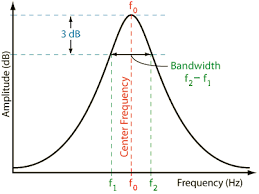
But a rule of thumb for selecting a good bandwidth is to have the bandwidth 5 times greater than the fundamental frequency of your measuring signal.
A very good point for beginners. If you have high bandwidth, and you are playing with a low-frequency signal, you do not get accurate results. You get a lot of noise instead of great results.
b. Sample Rate
The sample rate is the ability of an oscilloscope to how fast it can acquire the number of samples per second.
Or in simple words, it determines the amount of waveform information captured and displayed on the screen. The greater the sample rate, the more resolution it has, and as a result, you have every detail of your signal on display.
SR = 2.5*(Highest frequency in the signal)
The above equation is the Niquest criteria for sample rate. Oscilloscopes must obey this in order to be called good or the best beginner oscilloscopes. This is an industrial-adopted rule of thumb.
But some industry people also recommend a sample rate that is 3 to 5 times the bandwidth. The reason they provide is, that you need a high sample rate to see any unexpected glitches or anomalies.
In summary, the more samples you have in each period, the more signal detail you’ll capture. Let’s see what Keysight Labs have got for us about the sample rate and bandwidth.
A good point for noting down, without proper bandwidth, you will end in an attenuated or distorted signal. While without enough sample rate you will end up having no information that is very necessary to display the exact frequency, rise, and fall times of your signal. You can also miss any glitch or anomaly occurring instantly.
One important thing to double-check is the sample rate of the oscilloscope when all channels are turned on.
Typically, when multiple channels are in use, the sample rate is split up among the channels. If you are using more than one channel, you’ll want to make sure the sampling rate is still sufficient.
c. Memory Depth
Memory depth is the measure of the oscilloscope’s memory to store signals. More memory depth means you can capture signals at the highest sample rate. This is a very nice feature and a good oscilloscope must have a good size of depth memory. But it will make it costly.
The oscilloscope memory is directly tied to the sample rate. The more memory you have, the higher you can keep the oscilloscope’s sample rate as you capture a longer period of time. The higher the sample rate, the higher the effective bandwidth of the oscilloscope.
d. Waveform Update Rate
It is the time oscilloscope takes to update its screen. It is a very great and important feature to look for. Of course, who cares for an oscilloscope when it takes too much time to update its screen. As in such a situation, there is a good chance you may miss an important signal or a sudden glitch.
The high the waveform update rate (wfms/sec) is the better the chances to identify any glitches in your signal and therefore you have of course a better oscilloscope.
e. Size and cost
The one used in the lab is the bench oscilloscope. There may be people who will use an oscilloscope for car diagnoses. For such people, who carry oscilloscopes where and there, the size must be of great concern. The cost is a big issue.
But you cannot have a cheap oscilloscope with great features. It just cannot happen. Good bandwidth, sample rates, built-in wave generator, FFT, extra channels, and good memory depth are the parameters that will cost you money.
f. Number of channels
Two channels are more than enough if you are just starting with electronics. The reason is, that if you are going to use more than two channels, the extra channels are just making the scope expensive. For example, you want to see the communication of Arduino at the same time.
Two channels will be enough to see what is coming to your Arduino and what is going away from it or to see the phase difference between 2 pulse trains or any two signals.
Above are the key parameters that I think make the best oscilloscope buying guide completely. Besides these, there are features you should also take into consideration. Let’s talk about those in the following.
- Having a friendly graphical interface. There are a lot of scopes that have so ugly graphics that people find it very difficult to operate the scope accurately.
- Mathes functions including FFT.
- External triggering
- USB storing option
- Remote controlling option
- Solid-body structure
- EMI/EMC free reading
- Low noise level
- High-quality probes to reduce signal distortion
How oscilloscopes are priced?
Prices of oscilloscopes are based on many parameters but mostly on the following:
- The Bandwidth
- The Sample Rate
- Number of channels
- Memory depth
- Waveform update rate
The higher the above parameters, the higher the prices.
Famous best oscilloscopes brands
Let’s talk about brands for making quality best beginner oscilloscopes. Brand signals give feelings of trust. The higher the brand signals the more quality product you get, according to me.
There are a lot of manufacturers out there in the market. Not every one of them is good. There are some bad manufacturers as well that we need to avoid if we want to invest a decent amount of money. The following are the brands that have proved themselves in the industry over the years.
- Tekpower
- Rigol
- Siglent Technologies
- Korad Technology
- Keithley
- Keysight
- Aim-TTI
- Rohde and Schwarz
- GW Instek
- BK Precision
They are global brands and have a proven track record. I am sure if you are graduating from an engineering university you may have seen a scope from these brands in your labs.
Now, if I have confused you with too much technical stuff. Forget about the rest and just focus on the first two. The higher your bandwidth and sample rate requirements the higher you have to pay for a quality oscilloscope. And remember there is no cheap oscilloscope.
Conclusion
Thank you so much for making it to the end. I hope this article was kind of help to you.
As a reminder, the above products, the best oscilloscopes, are selected very carefully, keeping the user’s requirements and needs.
Selection is done by prioritizing the field professionals’ reviews, brands’ maturity, cost analysis, product testing, and a lot of other determining factors.
Thank you and have a grateful life.
Other useful posts:
- Best beginner multimeters: A complete buying guide
- #07 Best handheld Oscilloscope (Cheap and Portable)
- 7 Best USB oscilloscope for hobbyists & professionals
- Best Lab Power Supply [How to choose and buy the best]
- Best function generator[for hobbyists to professionals]
- Get Started with Electronics (Learning Guide)
